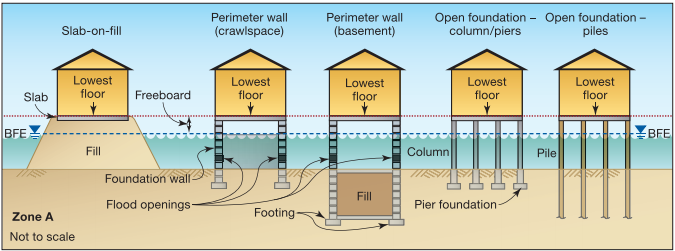Existing structures that are threatened with coastal flooding or erosion often can be moved up or elevated. You can check the FEMA Flood Map Service Center to see if your property is in a flood zone.
 If you are located in a flood zone, your town may require that the lowest structural part of your house be a minimum of one foot above the Base Flood Elevation (BFE). This is typically the minimum standard, but check with your local zoning enforcement officer for local ordinances. Source: FEMA Designing for Flood Levels Above the BFE, Home Builders Guide to Coastal Construction, Technical Fact Sheet 1.6
If you are located in a flood zone, your town may require that the lowest structural part of your house be a minimum of one foot above the Base Flood Elevation (BFE). This is typically the minimum standard, but check with your local zoning enforcement officer for local ordinances. Source: FEMA Designing for Flood Levels Above the BFE, Home Builders Guide to Coastal Construction, Technical Fact Sheet 1.6
If your structure has been flooded and does not meet current standards, or you are planning updates on your home, consider elevating your structure with a flow-through or pile foundation. If you are planning ‘substantial improvements,’ meaning that improvements meet or exceed 50% of the value of the structure, Floodplain Management regulations will require that your building be brought up to code, which may include elevating the building and its utilities.

Schematic of FEMA flood zone designations for coastal V, A and X zones Source: FEMA Region II Coastal Analysis and Mapping, Coastal Mapping Basics
The schematic below shows types of foundations that are National Flood Insurance Program (NFIP) compliant in A-zones where the elevation of the top of the lowest enclosed floor is above the BFE. For more specific information about the NFIP criteria, consult Hurricane Sandy Recovery Advisory No. 5, Designing for Flood Levels Above the Base Flood Elevation (2013).

Homes in coastal high hazard areas (V-zones) are required to have open foundations, that is, piers, columns, or piles. Open foundations reduce the surface area impacted by flooding and breaking wave loads on the structure and the risk of scour and erosion around the foundation. NFIP requires a licensed engineer or architect to design and certify foundations for buildings in V-zones.

The concept behind these foundation types is that water, sediment, and debris travel through the open foundation, instead of applying pressure and lateral force to the foundation, which can cause structural failure. Both foundation types can significantly reduce potential flood damage to a structure.
In some A zones (see diagram), fill can be added below a foundation to increase the elevation of the structure to meet floodplain standards. Care must be taken to ensure that this does not increase flood hazard impacts to adjacent properties.
Check with local zoning enforcement for specific standards (such as height restrictions) applicable to your lot when considering any potential elevation options.
Base Flood Elevations (BFEs) are shown on Flood Insurance Rate Maps (FIRMs) and on the flood profiles. Your town may have additional requirements that meet or exceed minimum FEMA standards. Contact your local Zoning Enforcement Officer for more information about building standards and requirements for each flood zone.
You may also want to review the FEMA Coastal Construction Manual and the FEMA Home Builder’s Guide to Coastal Construction Technical Fact Sheets. The Coastal Construction Manual is also available as a CD or in print copy by calling FEMA Publications Distribution Facility at 1-800-480-2520. Another source for building safe structures is FLASH (Federal Alliance for Safe Homes).
FEMA recommends consideration of elevating your structure over and above the elevation required by your floodplain ordinance to account for expected rates of sea-level rise and higher future floodplain elevations. This higher “freeboard” (or measure of safety above the base flood elevation) may also reduce flood insurance premiums. Information on financial grants for elevating homes in Connecticut can be found at ShoreUP Connecticut.
If you are considering elevating your home, think about elevating utilities, and designing improvements to ensure your home is more storm and flood resilient.
Save